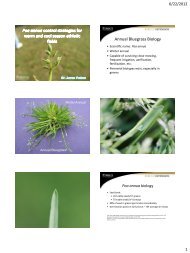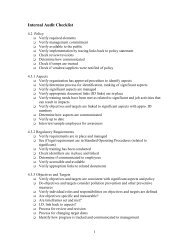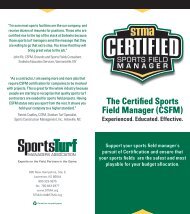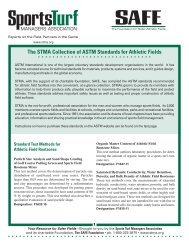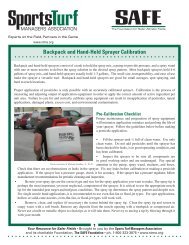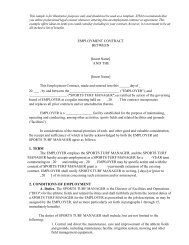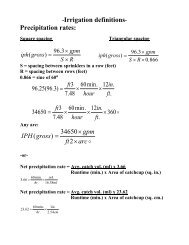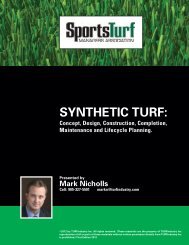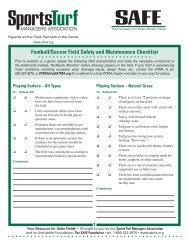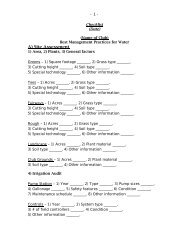Winter Athletic Field Maintenance Calendar for the ... - STMA
Winter Athletic Field Maintenance Calendar for the ... - STMA
Winter Athletic Field Maintenance Calendar for the ... - STMA
You also want an ePaper? Increase the reach of your titles
YUMPU automatically turns print PDFs into web optimized ePapers that Google loves.
www.stma.org<strong>Winter</strong> <strong>Athletic</strong> <strong>Field</strong> <strong>Maintenance</strong> <strong>Calendar</strong> <strong>for</strong><strong>the</strong> Transition Zone: December – FebruaryTaking appropriate steps to prepare your field <strong>for</strong> winterwill encourage healthy spring green up. Sports turfmanagers who dedicate <strong>the</strong>ir time and care to readyingfields <strong>for</strong> winter most often have healthy, successful fields<strong>the</strong> following spring.Temperatures and snow cover in your area will determinewinter maintenance practices. Dormant fields requireminimal maintenance. If you fields are overseeded orcontinuing to grow, <strong>the</strong> recommendations in this bulletinprovide guidelines on maintenance practices.MowingRecommended mowing heights:Commonor hybridbermudagrassPerennial,annual, orintermediateryegrassKentuckybluegrassTall FescueSeptember October November1-1.5 in 1-1.5 in 1-1.5 in1.5-3 inShould notexceed 3.5inches2-3.5 inShould notexceed 5inches1.5-3 inShould notexceed 3.5inches2-3.5 inShould notexceed 5inches1.5-3 inShould notexceed 3.5inches2-3.5 inShould notexceed 5inchesFrequencyBermudagrass goes dormant during cool temperatures,eliminating <strong>the</strong> need <strong>for</strong> mowing.Temperatures determine mowing frequency onoverseeded bermudagrass fields and cool seasonturfgrass fields. In warmer parts of <strong>the</strong> transition zone,fields should be mowed as often as needed if growthcontinues throughout <strong>the</strong> winter.Special ConsiderationsStay alert <strong>for</strong> frost. Avoid mowing (and turf use ingeneral) when <strong>the</strong>re is early morning frost. Traffic onfrosted turf ruptures leaf blades and <strong>the</strong> damage will likelybe visible into <strong>the</strong> following spring.If you are using growth blankets on your turf, keepmowing heights under one inch. Warm temperaturesand wet conditions during <strong>the</strong> winter months on turf overone inch can lead to disease problems.Photo courtesy of Jerad MinnickYour Resource <strong>for</strong> Safer <strong>Field</strong>s • Brought to you by <strong>the</strong> Sports Turf Managers Associationand its charitable Foundation, The SAFE Foundation • ph. 1-800-323-3875 • www.stma.org
<strong>Winter</strong> <strong>Athletic</strong> <strong>Field</strong> <strong>Maintenance</strong> <strong>Calendar</strong> <strong>for</strong><strong>the</strong> Transition Zone: December – February1/3 RuleA general rule when mowing any stand of turfgrass isto remove no more than 1/3 of <strong>the</strong> total leaf surface atone time.Effects of removing more than 1/3 of leaf surface:• Negatively affect photosyn<strong>the</strong>tic production offood• Deplete carbohydrate reserves in <strong>the</strong> plant roots• Graying or browning of leaf tips• Root growth restriction• Weed encroachment• Increased susceptibility to damage from insects,disease, drought and traffic• Excess clippingsDirectionChange direction each time <strong>the</strong> field is mowed. Thispromotes upright growth and can reduce wear fromequipment continually following <strong>the</strong> same pattern. Mowing<strong>the</strong> same direction creates ‘grain’ and <strong>the</strong> wavelike ridgesaffect <strong>the</strong> speed and direction of ball roll.Clipping CollectionClippings typically will not need to be collected if <strong>the</strong>turf is being mowed on a regular basis using <strong>the</strong> ‘1/3rdrule.’ However, variables such as wea<strong>the</strong>r conditions,season of <strong>the</strong> year, soil fertility, moisture conditions, growthrate of <strong>the</strong> turfgrass, and <strong>the</strong> surface playing characteristicsof <strong>the</strong> sport sometimes require clipping collection. Collectclippings if <strong>the</strong>y are so long and excessive that <strong>the</strong>ynegatively impact turf playability and/or turf health (i.e.blocking sunlight, increasing disease activity under <strong>the</strong>piles, etc.).Benefits of returning clippings:• Research at Penn State University shows that overa 3 year period, Kentucky bluegrass clippingsreturned 46-59% nitrogen to <strong>the</strong> plant.• Clippings contain nutrients that act as a fertilizer<strong>for</strong> <strong>the</strong> turf. Microbes in <strong>the</strong> soil hydrolyze <strong>the</strong>clippings into a solution that plants are capable ofusing.• Clippings comprised of leaf blades break downrapidly and do not contribute to thatch whenremoving no more than 1/3 of <strong>the</strong> leaf blade andclippings do not clump.Negative effects of excessive clippings:• Smo<strong>the</strong>r grass• Provide ideal environment <strong>for</strong> disease and insectsEquipmentNo matter what type of equipment is used to cut <strong>the</strong>turf, maintaining a sharp blade is <strong>the</strong> most importantelement to have a healthy, well groomed, aes<strong>the</strong>ticallypleasing turf.Reel Mowers• Provide <strong>the</strong> best cut <strong>for</strong> turf mown under 2 inches• Cut grass with a scissor or shearing action where<strong>the</strong>re actually is slight metal to metal contact.Blade and bedknife sharpness is important.• Can cause longer grass to lay over• Safer option to bystanders in comparison to rotarymowers – blade revolves slower and debris is rarelyprojected• Require careful maintenance to keep adjusted andsharpRotary Mowers• Provide <strong>the</strong> best cut <strong>for</strong> turf mown over 2 inches• Cut grass using impact. Speed of blade rotationcombined with blade sharpness cut <strong>the</strong> turf. Ifblade is not sharp, fraying may occur.• Blades revolve at high speed and may projectobjects from beneath <strong>the</strong> deck.Flail Mowers• Typically used on utility turf mown over 2 inchesbut improved models can be used on athleticfields.• Cuts grass by series of spinning, levered bladesin a self-contained deck. Since blades are freespinning,<strong>the</strong>y ‘give’ if <strong>the</strong>y strike a solid object andchances of blade breaking and being dischargedare negligible.• Ideal to use in park-like settings where sticks ando<strong>the</strong>r debris might exist as bystander safety isenhanced by <strong>the</strong> blade and deck design.Your Resource <strong>for</strong> Safer <strong>Field</strong>s • Brought to you by <strong>the</strong> Sports Turf Managers Associationand its charitable Foundation, The SAFE Foundation • ph. 1-800-323-3875 • www.stma.org
<strong>Winter</strong> <strong>Athletic</strong> <strong>Field</strong> <strong>Maintenance</strong> <strong>Calendar</strong> <strong>for</strong><strong>the</strong> Transition Zone: December – FebruaryIrrigationRecommended amounts per week (minus anyrainfall):NonoverseededbermudagrassfieldsOverseededbermudagrassfields(perennial,annual, andintermediateryegrass)Cool seasonturfgrassfields(Kentuckybluegrass,perennialryegrass,annualryegrass, andtall fescue)December January FebruaryWea<strong>the</strong>rdependentWea<strong>the</strong>rdependentWea<strong>the</strong>rdependentWea<strong>the</strong>rdependentWea<strong>the</strong>rdependentWea<strong>the</strong>rdependentAmount<strong>Winter</strong> is not an active growth period <strong>for</strong> turfgrassesdue to cold temperatures and possible snow cover.Irrigation is not necessary on dormant bermudagrass.For overseeded bermudagrass fields and o<strong>the</strong>r coolseason turfgrass fields, irrigation should occur on anas needed basis.<strong>Winter</strong>izing <strong>the</strong> Irrigation SystemThe irrigation system should be winterized be<strong>for</strong>e or during<strong>the</strong> month of December. O<strong>the</strong>rwise, water present in <strong>the</strong>pipes may freeze and lead to many problems <strong>the</strong> followingspring. If irrigation is necessary throughout <strong>the</strong> winter, <strong>the</strong>system can be charged with water and irrigation can takeplace. The system should be winterized again once <strong>the</strong>needed irrigation is completed.FertilizerRecommended amount of nutrients per month:NonoverseededbermudagrassfieldsBermudagrassfieldsoverseededwithperennial,annual, orintermediateryegrassKentuckybluegrassPerennialryegrassAnnualryegrassTall FescueDecember January FebruaryBermudagrass <strong>Field</strong>s0.5-1 lb.soluble N /1000 squarefeetUp to 0.5lb. solubleN / 1000square feet(wea<strong>the</strong>rdependent)Cool Season Turfgrass <strong>Field</strong>s1-2 lb. solubleN /1000 sq ft(dependenton fall sportsschedule)1-2 lb. solubleN /1000 sq ft(dependenton fall sportsschedule)1-2 lb. solubleN /1000 sq ft(dependenton fall sportsschedule)1-2 lb. solubleN /1000 sq ft(dependenton fall sportsschedule)Up to 0.5lb. solubleN / 1000square feet(wea<strong>the</strong>rdependent)Your Resource <strong>for</strong> Safer <strong>Field</strong>s • Brought to you by <strong>the</strong> Sports Turf Managers Associationand its charitable Foundation, The SAFE Foundation • ph. 1-800-323-3875 • www.stma.org
<strong>Winter</strong> <strong>Athletic</strong> <strong>Field</strong> <strong>Maintenance</strong> <strong>Calendar</strong> <strong>for</strong><strong>the</strong> Transition Zone: December – FebruaryTimingBermudagrass fieldsFertilizer applications are unnecessary on dormantbermudagrass fields.Bermudagrass fields overseeded with perennial, annual,and intermediate ryegrass per<strong>for</strong>m best with monthlyapplications of fertilizer. Small amounts of water solubleN (up to 0.5 lb. N / 1000 square feet) every four weekscan benefit winter trafficked fields in <strong>the</strong> warmer parts of<strong>the</strong> transition zone. However, turfgrass growth potentialis very low when air temperatures are less than 50 degreesFahrenheit. Fertilize only when plant response is possibleand never apply fertilizer to frozen soils. As temperatureswarm in late winter or early spring, appropriate fertilizationwill encourage growth, color, and recovery of turf.Applications of potassium at this time are also beneficialto fields. Potassium will help in decreasing potential <strong>for</strong>winterkill.Cool Season Turfgrass <strong>Field</strong>s<strong>Winter</strong> is not an ideal time to apply fertilizer on coolseason turfgrass fields. However, fertilizer may need tobe applied this late in <strong>the</strong> season if <strong>the</strong> last game on <strong>the</strong>fall sports schedule occurs in December. Water solublenitrogen can be applied at 1-2 pounds per 1000 square feetto promote early spring green up. Late season fertilizationshould occur only when shoot growth stops, grass is stillgreen and be<strong>for</strong>e <strong>the</strong> soil freezes. Application to frozensoils can negatively impact water quality due to runoff.Applications of potassium at this time are also beneficialto fields. Potassium will help in decreasing potential <strong>for</strong>winterkill.Special ConsiderationsIf growth blankets are being used, monitor your turf areasclosely when applying nitrogen. If a winter is wet andwarm, excessive nitrogen can lead to disease problems.Photo courtesy of James Brosnan, Ph.D.Soil TestingSoil tests should be conducted on a routine basis –every one (sand-based fields) to three (native soil fields)years is recommended. A soil test will analyze nutrientrequirements, pH, phosphorus and potassium levels, andwill provide <strong>the</strong> best guide to fertilization to maintain orachieve a healthy field.NutrientsSoils with suitable pH levels and appropriate balances ofnutrients promote winter hardiness of both warm and coolseason grasses. However, when additional nutrients areneeded, winter applications are often ineffective due to<strong>the</strong> low activity of <strong>the</strong> turfgrass root system. Beneficialresponses of <strong>the</strong> nutrients can occur only if <strong>the</strong>y areabsorbed by <strong>the</strong> plant and not that <strong>the</strong>y simply occur in <strong>the</strong>soil. Supplemental nutrient applications should be madeduring <strong>the</strong> optimal growing conditions of <strong>the</strong> fall.The macronutrients required <strong>for</strong> turfgrass growthinclude nitrogen (N), phosphorus (P), potassium (K),calcium (Ca), magnesium (Mg), and sulfur (S).Nutrient effects on turfgrass growth and health:• Nitrogen – Influences color, shoot growth, shootdensity, root growth, rhizome and stolon growth,carbohydrate reserves, high temperature stress,cold tolerance, drought resistance, wear tolerance,thatch accumulation, disease susceptibility andrecuperative potential.Your Resource <strong>for</strong> Safer <strong>Field</strong>s • Brought to you by <strong>the</strong> Sports Turf Managers Associationand its charitable Foundation, The SAFE Foundation • ph. 1-800-323-3875 • www.stma.org
<strong>Winter</strong> <strong>Athletic</strong> <strong>Field</strong> <strong>Maintenance</strong> <strong>Calendar</strong> <strong>for</strong><strong>the</strong> Transition Zone: December – February• Phosphorus – Involved in transfer and storage ofenergy <strong>for</strong> metabolic processes in turf. Affectsseedling development, maturation, root growth andseed production. Needed during establishment.Phosphorus has been eliminated in many fertilizersdue to potential environmental concerns. Also,soil that already has adequate phosphorus, does notneed any additional from a fertilizer application.This is one reason why soil tests are necessary.• Potassium – Involved in photosyn<strong>the</strong>sis; Importantin <strong>the</strong> regulation of stomates and internal watermanagement; Maintain turgor pressure in plants;Affect root growth, heat, cold and droughttolerance, wear tolerance, disease susceptibility,and environmental stress resistance• Calcium – Aids in cell wall structure and new cell<strong>for</strong>mation; Stimulates root and leaf development• Magnesium – Involved in <strong>for</strong>mation of proteins;Found in chlorophyll molecule; Improves P uptakefrom soil; Aids in plant respiration• Sulfur – Involved with <strong>for</strong>mation of proteins;Helps with turf growth, green color, shoot growthand density, root growth, carbohydrate reserves,and disease susceptibilityThe micronutrients required <strong>for</strong> turfgrass growthinclude iron (Fe), manganese (Mn), zinc (Zn), copper(Cu), boron (B), molybdenum (Mb), chlorine (Cl),nickel (Ni). Adequate amounts of micronutrients areusually present in <strong>the</strong> soil as long as pH is appropriate.Excess amounts of <strong>the</strong>se nutrients are more commonlyseen than deficiencies. Deficiencies are much more likelyin sand-based soils than heavier textured native soils.LimeProper liming is as important as fertilization. Properlymanaged soil pH regulates nutrient availability and createsa soil environment not only desirable <strong>for</strong> turf, but also <strong>for</strong>healthy soil microorganisms. Late fall and early winter canbe an ideal time to apply lime if it is needed to adjust soilpH. Lime should not be applied to frozen soil and/or turf.The desired soil chemical responses from lime applicationsoften take weeks/months, so soil pH can be adjusted priorto <strong>the</strong> active growing season of <strong>the</strong> spring. Lime shouldonly be applied in accordance with what is recommendedon soil test results. If recommended amounts exceed 50pounds per 1000 square feet, apply in split applications.RootzoneNutrient holding capacity of a rootzone variesdepending on soil texture. Heavy, fine textured soils holdmore nutrients than light, sandy soils. A rootzone with lownutrient retention is often best managed with light and morefrequent fertilization unless water insoluble fertilizers areapplied. Use tissue and soil tests to determine <strong>the</strong> amountsand application frequency needed to maintain a healthyturf environment.ProductsNutrients applied at appropriate times late in <strong>the</strong> growingseason will encourage root growth, food storage, anddensity of turf. Fertilizer should only be applied if whenshoot growth stops, grass is still green and be<strong>for</strong>e <strong>the</strong> soilfreezes. A quick release water soluble fertilizer can beapplied to promote spring green up <strong>the</strong> following year.Make sure to check with your local and state agencies<strong>for</strong> any restrictions on applying nutrients. For areaswith restrictions on inputs or o<strong>the</strong>r managementprogram constraints or objectives, <strong>the</strong>re are organic andmicrobial products available in <strong>the</strong> marketplace. <strong>STMA</strong>encourages you to talk with vendors and practitioners <strong>for</strong>recommendations to fit your specific needs.EquipmentRotary spreadero The most rapid way to apply product as fertilizer isdistributed in a wide pattern.o Holes in <strong>the</strong> bottom of <strong>the</strong> hopper drop granuleson to a rotating impeller that slings granules in apattern wider than <strong>the</strong> spreader.o Distribution is not uni<strong>for</strong>m and is more concentratedin <strong>the</strong> middle of <strong>the</strong> pass.o To achieve uni<strong>for</strong>mity, on each pass, granulesshould reach <strong>the</strong> wheel path of <strong>the</strong> previous pass.o Splitting <strong>the</strong> application in half and applyingmaterial in two directions can help eliminatestriping.Your Resource <strong>for</strong> Safer <strong>Field</strong>s • Brought to you by <strong>the</strong> Sports Turf Managers Associationand its charitable Foundation, The SAFE Foundation • ph. 1-800-323-3875 • www.stma.org
<strong>Winter</strong> <strong>Athletic</strong> <strong>Field</strong> <strong>Maintenance</strong> <strong>Calendar</strong> <strong>for</strong><strong>the</strong> Transition Zone: December – FebruaryNon-overseeded bermudagrass fieldsBermudagrass seeding or sprigging is not recommendedduring <strong>the</strong> winter because bermudagrass goes dormant.Bermudagrass requires warm temperatures <strong>for</strong> properestablishment. Sod can be installed essentially any timeof <strong>the</strong> year soil is not frozen. However, if <strong>the</strong> field isto be played upon <strong>the</strong> following spring, bermudagrasssod installations should occur by early to mid-fall at <strong>the</strong>latest, and many times it is desirable to install a ryegrassoverseeded sod that will provide <strong>the</strong> desired stability <strong>for</strong>spring sports due to ryegrass rooting.Photo courtesy of Chad Price, CSFMSeedingRecommended months to apply seed, sprigs or sod:Non-overseededbermudagrassfieldsOverseededbermudagrassfieldsKentuckybluegrassPerennialryegrassDecember January FebruaryX X XX X XX X XAnnual ryegrass X X XTall Fescue X X XRecommended seeding rates:KentuckybluegrassPerennialryegrassAnnualryegrassTall Fescue2-3 lb. / 1000 sq ft4-10 lb. / 1000 sq ft4-10 lb. / 1000 sq ft5-8 lb. / 1000 sq ftOverseeded bermudagrass fieldsOverseeding with perennial, annual, and intermediateryegrass can continue throughout <strong>the</strong> winter on dormantbermudagrass fields. However, germination andestablishment during extreme cold will be minimal at best.Much of <strong>the</strong> seed will remain ‘dormant’ until suitabletemperatures and moisture are received (see description ofdormant seeding and possible benefits of growth coversbelow). In warmer parts of <strong>the</strong> transition zone, seedingwill help maintain turf density, provide winter color, andimprove wear recovery.Sod can be installed at anytime as long as <strong>the</strong> soil isnot frozen. However, if <strong>the</strong> field is to be played upon<strong>the</strong> following spring, bermudagrass installations shouldoccur by early to mid-fall at <strong>the</strong> latest, and many timesit is desirable to install a ryegrass overseeded sod thatwill provide <strong>the</strong> desired stability <strong>for</strong> spring sports due toryegrass rooting.Cool season turfgrass fieldsSeed can be applied to dormant turf or following late seasoncultivation. Dormant seeding is when seed is applied todormant turf or frozen soil and lies dormant until soiltemperatures warm in April or May. Dormant seeding cantake place beginning in November and continue as late asMarch. Growth covers can be used to assist in seedlinggermination and enhance development during <strong>the</strong> winter.These breathable covers protect seedlings from frost andfreeze damage. Turf managers must monitor ground and airtemperature, and snow and rain amounts closely <strong>for</strong> dormantseeding success. Increased temperature and moisture beneath<strong>the</strong> blankets can lead to growth and pest problems.Your Resource <strong>for</strong> Safer <strong>Field</strong>s • Brought to you by <strong>the</strong> Sports Turf Managers Associationand its charitable Foundation, The SAFE Foundation • ph. 1-800-323-3875 • www.stma.org
<strong>Winter</strong> <strong>Athletic</strong> <strong>Field</strong> <strong>Maintenance</strong> <strong>Calendar</strong> <strong>for</strong><strong>the</strong> Transition Zone: December – FebruaryDormant seeding is beneficial because as <strong>the</strong> soil heavesand cracks during <strong>the</strong> winter, crevices are created <strong>for</strong><strong>the</strong> seeds. This creates ideal germination conditions astemperatures begin to warm. The seed can also succumbto many fates while it sits on <strong>the</strong> surface <strong>for</strong> months waitingto grow. Disadvantages associated with dormant seedinginclude seed rot, seed desiccation, or runoff due to water.Sod can be installed at any time as long as <strong>the</strong> soil is notfrozen. Consider that sodding during warmer temperatureswill better ensure root development and a stable playingsurface.Species and MixturesAlways use certified seed when overseeding athleticfields. Certification ensures that <strong>the</strong> cultivar listed on <strong>the</strong>label is what is contained in <strong>the</strong> bag. The label also lists atest date. Seed should not be sold if <strong>the</strong> test date is morethan 15 months past.The species used <strong>for</strong> overseeding depends on <strong>the</strong> currentspecies on <strong>the</strong> field and <strong>the</strong> amount of play <strong>the</strong> field willbe receiving within six weeks of seeding.Kentucky bluegrass• Fine texture• Resilient due to rhizomatous growth• Traffic should not be allowed on <strong>the</strong> field until itis fully established due to slow germination andestablishment rates.• Once established, produces better wear toleranceand recovery.• Drought tolerant• If <strong>the</strong> field is made up of 100% Kentucky bluegrass,a blend of different cultivars should be used tomaximize disease resistance and wear tolerance.• Most fields are a mixture of Kentucky bluegrass(80-90%) and perennial ryegrass (10- 20%). Thegermination and recovery rate of perennial ryegrassaid in maintaining turf cover and density on <strong>the</strong>sefields.Perennial ryegrass• Fine texture• Quick establishment• Good traffic and wear tolerance when combinedwith Kentucky bluegrass• Poor cold tolerance• Most fields are a mixture of Kentucky bluegrass(80-90%) and perennial ryegrass (10-20%). Thegermination and recovery rate of perennial ryegrassaid in maintaining turf cover and density on <strong>the</strong>sefields.Annual ryegrass• Used primarily <strong>for</strong> winter overseeding and/or soilstabilization• Coarse to medium texture• Quick germination and quick recovery potential• Provides green color throughout fall, winter andspring• Poor drought and heat tolerance. Usually dies withhot summer temperaturesIntermediate ryegrass• This hybrid seeks to provide <strong>the</strong> rapid establishmentrate of annual ryegrass with improved turf qualityand wear characteristics of perennial• Cost similar to perennial ryegrass• Moderate to good wear tolerance• Coarser texture than perennial• Light green color typical but newer varieties aredarker green• Dies out naturally in early summerTall Fescue• Fine to medium texture• Good pest tolerance• Most drought and heat tolerant of all <strong>the</strong> coolseason grasses• Poor tolerance to mowing heights less than 2inches• Good wear tolerance• Good spring greening• Poor cold tolerance• Popular choice on low-input athletic fields as amonostand; when used on higher maintenanceathletic fields, tall fescue should not be mixed withmore than 10% of Kentucky bluegrass. Due to tallfescue’s bunch type growth, Kentucky bluegrass isoften added to help knit plants toge<strong>the</strong>r and providebetter recuperative potential.Your Resource <strong>for</strong> Safer <strong>Field</strong>s • Brought to you by <strong>the</strong> Sports Turf Managers Associationand its charitable Foundation, The SAFE Foundation • ph. 1-800-323-3875 • www.stma.org
<strong>Winter</strong> <strong>Athletic</strong> <strong>Field</strong> <strong>Maintenance</strong> <strong>Calendar</strong> <strong>for</strong><strong>the</strong> Transition Zone: December – FebruaryPest ControlHealthy, dense stands of turf are <strong>the</strong> best way to preventdisease, weed or insect infestations. Following propercultural practices throughout <strong>the</strong> year, includingfertilization, irrigation, mowing, seeding, and soilcultivation, can minimize and sometimes eliminatepest problems. The goal of turf management is to producehealthy turf while limiting reliance on pesticides. Manymanagers follow Integrated Pest Management (IPM)practices. This program does not completely eliminatepests, but maintains <strong>the</strong> population at a tolerable level.Pesticides are often a part of IPM programs, but <strong>the</strong>y areselected and applied responsibly to avoid health risks too<strong>the</strong>r living organisms than those targeted. It is importantto routinely scout <strong>the</strong> fields and identify <strong>the</strong> pest problemin <strong>the</strong> early stages so a decision can be made whe<strong>the</strong>rits effects need to be controlled culturally or chemically.University research and ef<strong>for</strong>ts by turf managers andcommunities continue to evolve and support <strong>the</strong> trendtowards sustainable turf management.Make sure to check with your local and state agencies<strong>for</strong> any restrictions on applying pesticides. Forareas with restrictions on inputs or o<strong>the</strong>r managementprogram constraints or objectives, <strong>the</strong>re are organic andmicrobial products available in <strong>the</strong> marketplace. <strong>STMA</strong>encourages you to talk with vendors and practitioners <strong>for</strong>recommendations to fit your specific needs.WeedsRecommended time to apply herbicides:Timing <strong>for</strong>controlWeeds mostcommonlycontrolledon dormantbermudagrassandoverseededbermudagrassfieldsTiming <strong>for</strong>controlDecember January FebruaryBermudagrass <strong>Field</strong>sX X XPostemergentcontrol ofwinter annualand perennialbroadleafweedsPostemergentcontrol ofwinter annualand perennialbroadleafweedsCool Season Turfgrass <strong>Field</strong>sPostemergentcontrol ofwinter annualand perennialbroadleafweedsPreemergentcontrol ofsummerannual weedygrassesNon-overseeded bermudagrass fieldsAnnual bluegrass and winter annual and perennialbroadleaf weeds can invade dormant bermudagrass fields.Left uncontrolled, <strong>the</strong>se weeds can compete <strong>for</strong> sunlightwith bermudagrass <strong>the</strong> following spring. This can delaygreen-up. Preemergent and postemergent herbicides canbe applied to dormant bermudagrass to control weeds.Applying a broad spectrum, non-selective herbicide isa common method <strong>for</strong> controlling weeds in dormantbermudagrass. Remember, bermudagrass must becompletely dormant when making a broad spectrum,non-selective herbicide application.Overseeded bermudagrass fieldsAnnual bluegrass and winter annual and perennialbroadleaf weeds compete with overseeded grasses during<strong>the</strong> winter. Postemergent herbicides are preferable <strong>for</strong>overseeded fields. Spot treating weeds may be a desirablemethod of control as opposed to broadcast applications.Never apply herbicides if <strong>the</strong> turf is stressed.Your Resource <strong>for</strong> Safer <strong>Field</strong>s • Brought to you by <strong>the</strong> Sports Turf Managers Associationand its charitable Foundation, The SAFE Foundation • ph. 1-800-323-3875 • www.stma.org
<strong>Winter</strong> <strong>Athletic</strong> <strong>Field</strong> <strong>Maintenance</strong> <strong>Calendar</strong> <strong>for</strong><strong>the</strong> Transition Zone: December – FebruaryCool season turfgrass fieldsIn order to abide by IPM standards, herbicide applicationsare uncommon during <strong>the</strong> winter. Some turf managersmay take this opportunity to eliminate winter annuals andperennial broadleaves with a postemergent product.Common <strong>Winter</strong> WeedsGrassy weeds• Annual bluegrass• Annual ryegrass• OrchardgrassBroadleaf weeds• Common chickweed• Corn speedwell• Henbit• Purple deadnettle• Shepherd’s Purse• Veronica• Lawn burweed• Carolina geranium• Hop clover• Parsley-piert• Mouse-ear chickweed• Buttercup• Dandelion• White clover• Broadleaf plantain• Buckhorn plantain• Ground ivy• Curly dock• Broadleaf dock• Oxalis• Wild strawberry• Wild Violet• Prostrate knotweedO<strong>the</strong>r weeds• Wild Garlic• Wild OnionInsectsTiming of insect damage and <strong>the</strong> grass speciesaffected:Commonbermudagrassand hybridbermudagrassPerennial,annual, andintermediateryegrassKentuckybluegrassDecember January FebruaryTall FescueInsects are generally not a problem on sports fieldsduring cooler temperatures.DiseasesTiming of disease occurrence:Commonbermudagrassand hybridbermudagrassKentuckybluegrassPerennial,annual andintermediateryegrassTall FescueDecember January FebruaryGray snowmold, pinksnow moldGray snowmold, pinksnow moldGray snowmold, pinksnow moldGray snowmold, pinksnow moldGray snowmold, pinksnow moldGray snowmold, pinksnow moldGray snowmold, pinksnow moldGray snowmold, pinksnow moldGray snowmold, pinksnow mold10Your Resource <strong>for</strong> Safer <strong>Field</strong>s • Brought to you by <strong>the</strong> Sports Turf Managers Associationand its charitable Foundation, The SAFE Foundation • ph. 1-800-323-3875 • www.stma.org
<strong>Winter</strong> <strong>Athletic</strong> <strong>Field</strong> <strong>Maintenance</strong> <strong>Calendar</strong> <strong>for</strong><strong>the</strong> Transition Zone: December – FebruaryDisease TriangleDiseases occur when three factors are present and meet <strong>the</strong>correct conditions.1) A susceptible host – The grass plants are <strong>the</strong> hosts;choose resistant and/or tolerant varieties wheneverpossible.2) A virulent pathogen – The disease-incitingorganism is almost always present in <strong>the</strong> soiland not causing problems. However, conditionssometimes change and it can attack <strong>the</strong> turf.3) A suitable environment – When certainenvironmental conditions are present, disease mayoccur. For example, hot, humid wea<strong>the</strong>r oftencontributes to <strong>the</strong> appearance of some diseases.Pink snow mold• Symptoms – Circular areas of turf turn tan, lightgray, or orange-brown. Fluffy mycelium may bepresent that appears pink in sunlight. Snow doesnot need to be present <strong>for</strong> development.• Prevention – Avoid heavy applications of quickrelease nitrogen in late fall. Keep turf height lowto prevent leaves from matting. If <strong>the</strong> field hasa history of snow mold, a preventative fungicideapplication can be applied just be<strong>for</strong>e <strong>the</strong> firstsignificant snowfall.Chemical ControlProper mowing, irrigation, fertilization, and cultivationcan all lead to a healthy, dense field that is able towithstand moderate disease infestations. Unless fieldshave a history of poor disease tolerance, in order to abideby IPM standards, preventative fungicide applications areoften not necessary. If <strong>the</strong> field is affected by a disease, acurative application should be sufficient.If turf blankets are being used, carefully monitor <strong>the</strong> area<strong>for</strong> disease. Warm, wet wea<strong>the</strong>r during <strong>the</strong> winter canincrease <strong>the</strong> likelihood <strong>for</strong> disease appearance. Fungicideapplications may be necessary depending on winterwea<strong>the</strong>r.Symptoms and Preventative MeasuresGray snow mold• Symptoms – Circular areas of turf turn yellow orgray/brown. Wet leaves become matted toge<strong>the</strong>rand are covered with gray or white mycelium. Dryleaves are gray and brittle with no mycelium. Adefining characteristic is <strong>the</strong> small, hard, roundsclerotia on infected leaves. They can be white,pink, brown or black. Gray snow mold requiressnow <strong>for</strong> development..• Prevention – Avoid heavy applications of quickrelease nitrogen in late fall. Avoid excessivethatch and prevent compaction. Keep turf heightlow to prevent leaves from matting. Promote aircirculation in early spring by removing snow andensuring proper drainage.Off Season <strong>Maintenance</strong><strong>Winter</strong> is also a great time to devote to equipmentmaintenance and repair. <strong>Maintenance</strong> to prepare <strong>for</strong> <strong>the</strong>upcoming spring season can include, sharpening mowerblades, oil changes, routine inspection and safety checks,cleaning, and o<strong>the</strong>r major repairs. Proper equipmentmaintenance and care prolongs <strong>the</strong> life of equipmentand saves money in <strong>the</strong> long run. If equipment is notfunctioning properly, winter may be a good time to replaceand upgrade your inventory.Conducting routine field and facility safety checks areimportant throughout <strong>the</strong> year. However, busy sportsand maintenance schedules can sometimes compete withtasks on <strong>the</strong> priority list. Take this opportunity to checkyour fields and surrounding facility <strong>for</strong> any necessarymaintenance to prepare <strong>for</strong> <strong>the</strong> upcoming season.11Your Resource <strong>for</strong> Safer <strong>Field</strong>s • Brought to you by <strong>the</strong> Sports Turf Managers Associationand its charitable Foundation, The SAFE Foundation • ph. 1-800-323-3875 • www.stma.org
<strong>Winter</strong> <strong>Athletic</strong> <strong>Field</strong> <strong>Maintenance</strong> <strong>Calendar</strong> <strong>for</strong><strong>the</strong> Transition Zone: December – February<strong>Calendar</strong>sGeneral ovserview of necessary maintenance practices per<strong>for</strong>med during <strong>the</strong> winter on non-overseeded bermudagrassfields:MowingIrrigationFertilizerPlant GrowthRegulatorsCultivationSeedingDecember January FebruaryWeed Control X X XInsect ControlDisease ControlGeneral overview of necessary maintenance practices per<strong>for</strong>med during <strong>the</strong> winter on overseeded bermudagrass fields(maintenance of perennial, annual or intermediate ryegrass)December January FebruaryMowing X X XIrrigation X (wea<strong>the</strong>r dependent) X (wea<strong>the</strong>r dependent) X (wea<strong>the</strong>r dependent)Fertilizer X X XPlant GrowthRegulatorsCultivationSeeding X (optional) X (optional) X (optional)Weed Control X X XInsect ControlDisease Control Monitor <strong>for</strong> disease Monitor <strong>for</strong> disease Monitor <strong>for</strong> disease12Your Resource <strong>for</strong> Safer <strong>Field</strong>s • Brought to you by <strong>the</strong> Sports Turf Managers Associationand its charitable Foundation, The SAFE Foundation • ph. 1-800-323-3875 • www.stma.org
<strong>Winter</strong> <strong>Athletic</strong> <strong>Field</strong> <strong>Maintenance</strong> <strong>Calendar</strong> <strong>for</strong><strong>the</strong> Transition Zone: December – FebruaryGeneral overview of necessary maintenance practices per<strong>for</strong>med during <strong>the</strong> winter on cool season turfgrasses:December January FebruaryMowing X (wea<strong>the</strong>r dependent) X (wea<strong>the</strong>r dependent) X (wea<strong>the</strong>r dependent)Irrigation X (wea<strong>the</strong>r dependent) X (wea<strong>the</strong>r dependent) X (wea<strong>the</strong>r dependent)Fertilizer X (dependent on fall sportsschedule)Plant GrowthRegulatorsCultivationX (dependent on fall sportsschedule)Seeding X X XWeed ControlInsect ControlDisease Control X X X13Your Resource <strong>for</strong> Safer <strong>Field</strong>s • Brought to you by <strong>the</strong> Sports Turf Managers Associationand its charitable Foundation, The SAFE Foundation • ph. 1-800-323-3875 • www.stma.org



